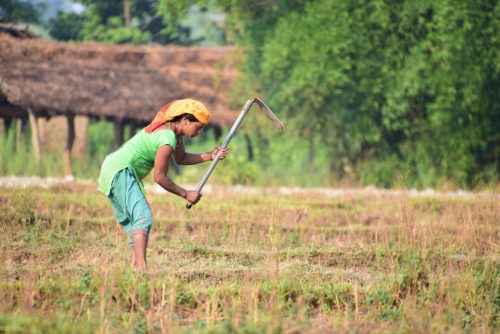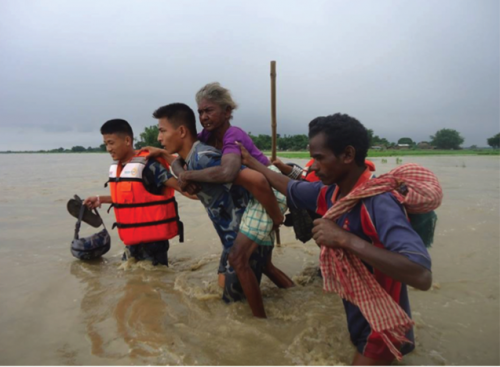What do we mean by gender equity and social inclusion? And why does it matter for community flood resilience? This blog explores these complex concepts, and will soon be followed by part two – with practical questions to guide reflection to help make our work more equitable and inclusive.
What do we mean by Gender Equity and Social Inclusion in Flood Resilience?
Gender equity and social inclusion means promoting the active engagement and empowerment of social groups that experience disproportionate effects of flood disasters. It can be both a means and an end goal itself. Gender equity – compensating the most historically and socially disadvantaged – is a precursor to equality.
Dynamics of gender and power
‘Gender’ and ‘sex’ are not interchangeable.
Despite the essentialist binaries of the two sexes – male and female – being the dominant view, it is often not the reality with which many live their lives. ‘Gender’ refers to the presumed differences, roles and expectations ascribed to each group.
Most societies are patriarchal and heteronormative. ‘Patriarchy’ is the system which privileges male power. ‘Heteronormativity’ is the logic that sees two discrete gender groups and heterosexuality as the norm.
These systems privilege cisgender men and traits perceived to be ‘masculine’ (reason, agency, objectivity and physical strength) over those considered feminine. This power imbalance is to the detriment of women and gender minorities, although men also suffer.
In these systems, women are often characterized as dependent or physically inferior. They are socialized into roles that lack personal autonomy and rationality, and out of leadership and decision-making roles. This is especially true in the context of disaster risk. The reality is that these inequities are a result of unequal power dynamics between men and women.
However, women are not a homogenous group and there is nothing universal about being a woman which necessitates behaving in a certain way. All roles and experiences are remarkably diverse. Gender does not dictate who can be leaders, who can adapt to challenges or provide solutions.

When referring to gender and power, it’s important to look beyond the relationships between men and women. We need to look at the gendered and power dimensions of all kinds of social relationships.
Identity and social exclusion
Gender is one way to identify someone. Other ways may include: age, (dis)ability, race, class, sexuality, ethnicity, religion, geography, health status or occupation.
There are also differences within these groups. Identity is made up of different factors which depend heavily on local norms and cultural nuances. These determine the extent of the power, agency and access that individuals have in their own lives, and consequently determines their level of risk in the face of hazards like floods.
Sex, age and disability (SAD) are now recognized as important minimum standards to collect and disaggregate data on in disaster risk reduction. Where possible, it can be important to go beyond these and gather data on and understand other identities, how they interact and how this might affect people’s vulnerability to floods.
Taking an intersectional approach to flood resilience
Intersectionality emphasizes “the constant renegotiation of power relations and how individuals and groups can experience both power and oppression simultaneously”.

Taking an intersectional approach means looking at different identities and how they interact. For example, the intersection of gender with race, age, disability, class, vocation. By doing this we uncover the range of dynamics that shape vulnerability and resilience.
In every context, there are cultural nuances, inequalities and pressures to perform gendered social roles. There are differences in access to markets, assets, resources, power, workload, livelihoods and more. These could manifest as reduced income-generating opportunities or a lack of decision-making power. Understanding these dynamics, intersecting identities and power relations is very important. It is a crucial first step to understanding vulnerability and risk, and how to support communities to build their resilience.
Gender equity and social inclusion in flood disasters
When a hazard strikes there is a gendered difference between how people experience it. This determines the level of ‘disaster’ experienced by different people.

Women and other marginalized people suffer higher mortality and morbidity rates as a result of hazard impacts. Disasters may also worsen and prolong the inequalities that made them more vulnerable in the first place. Often, vulnerable communities have experienced crises in the past, which have compounded and prolonged their vulnerability. Climate chaos will continue to put them at risk. Cultural norms and power relations can all result in higher incidences of injury, mortality or loss. This could be due to reduced mobility through clothing, barriers to early-warning information such as illiteracy, or lack of opportunity to learn certain skills like swimming. It might be a result of less household decision-making power.
Taking a gender equity and social inclusion approach to increasing resilience means considering the differences between people from all of these groups. It means making informed decisions to design and select solutions which have a positive impact for different people. If we ignore them, we risk reinforcing or exacerbating these relations.
Keep learning
The value of this work is often as much in the thinking and reflection as in the outcomes. Keep an eye out for the second blog in this series. There we will ask many of the questions we need to address in our work on gender equity and social inclusion, from ‘getting our own house in order’ to designing gendered interventions.
In the meantime we’ve brought together some more resources you might find helpful:
- Missing Voices: Experiences of floods and early warning from marginalized women in Nepal and Peru
- Gender Transformative Early Warning Systems
- Powercube.net
- Gender Mainstreaming: An overview
- Gender and Resilience
- Gender planning and development: Revisiting, deconstructing and reflecting
- Gender and Inclusion Toolbox: Participatory Research in Climate Change and Agriculture
- Building resilience for all: Intersectional approaches for reducing vulnerability to natural hazards in Nepal and Kenya

Bikram Rana Tharu says:
Congratulations Lydia for this good piece.
Caspar says:
Really interesting blog. It’s great to see the nuance in the understanding of gender and other identity factors – too often lumped into homogeneous groups!.
I’m interested to know more about how gender roles play out during a disaster. For example, how patriarchal views around caring responsibilities affect risk during an event. And even more interested to know how experiences vary between women.